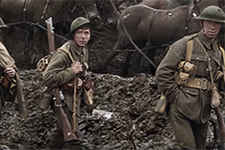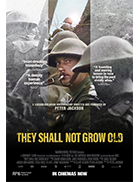They Shall Not Grow Old
|  Much has been—rightly—made about the technical aspects of Peter Jackson’s documentary They Shall Not Grow Old, which recreates the experience of British soldiers on the Western Front during World War I via restored footage from the Imperial War Museum (most of which has never been publicly screened). Much of the footage has been colorized and converted to 3D, and the effect is one of unique immersion. The previously scratchy, grainy, age-marked images, with their instability and awkward, inconsistent frame rates, have been brought into a modern visual vernacular, smoothed out, colorized, and otherwise made to bridge the gap between then and now. The footage is still distinctly archival, bearing with it a sense of authenticity that can’t be fully recreated by even the most accomplished of cinematic technicians, but at the same time it feels revelatory, as if we are there with the soldiers, rather than watching footage of them. It brings the past into the present in a truly unique way. As important and effective as the film’s visual approach is, though, what truly makes the film work is Jackson’s decision to eschew the traditional narrative approach that often accompanies war documentaries involving third-person narration and an abundance of historical facts—names, dates, locations, and so forth. Instead, Jackson and his team culled through some 600 hours of audio interviews with British servicemen who fought in World War I archived at the BBC and the Imperial War Museum and edited together a singular narrative composed of 120 different voices all telling the same story of what it was like to be a solider in that time and place. We are never given any names, and the audio has been carefully selected and edited to leave out specifics, instead painting a broad portrait of an existence unique in world history. There is humor in the recounting, particularly complaints about the monolithic diet they ate (apparently apple-plum jam wore out its welcome quickly) and details about the awkwardness involved in men relieving themselves while on the front lines. But, there is also horror, especially once the film moves into the trenches and we hear about men seeing their fellow soldier’s heads blown apart, having to walk across fields of bodies, and the distinct smell of human decay, the repulsiveness of which was intensified by its ultimate familiarity on the battlefield. These now old men’s voices fill the film’s soundtrack, weaving together a narrative tapestry that takes us from their initial enlistment (some of them were as young as 15 at the time), through their training, and finally to the front lines, where they saw, heard, and felt an overwhelming cacophony of human violence that most of us will never have to experience. Some of them are quite matter-of-fact in their recountings, while others are clearly brought to the brink of tears, their stiff British upper lips audibly quivering. They are, at all times though, distinctly human and humane, never wallowing in perceived glory or self-aggrandizement, but rather approaching the horrors they endured as a job that, in that moment, had to be done. (The film is dedicated to Jackson’s grandfather, Sgt. William Jackson, whose wartime stories were related to the filmmaker via his father.) That job necessarily entails a lot of horror, and Jackson doesn’t shy away from showing us grisly images of the war dead, made all the more immediate by the red of the blood and the visual detail of shattered bodies (the film’s title derives from Laurence Binyon’s 1914 poem “For the Fallen”— “They shall grow not old, as we that are left grow old”). It is impossible, of course, to discuss They Shall Not Grow Old without grappling with Jackson’s technical and aesthetic decisions, which are mostly effective, although there can be drawbacks. Like James Cameron, another blockbuster filmmaker who has also been drawn to intensifying the documentary format with new technologies, Jackson repurposes the digital tools he has used to give new visual life J.R.R. Tolkien’s Middle Earth in the six Lord of the Rings and Hobbit films to restore and enhance long unseen footage of real men in real locations. The decision to colorize and make most of the footage stereoscopic is a potentially controversial one, as it introduces a degree of artistic license that could potentially undermine the footage’s authenticity. Of course, one can always argue that documentary footage, no matter how “pure” and unadulterated by the human hand, always presents a limited perspective that fails to tell the whole story and is usually framed and contextualized by editing, which necessarily privileges some material over other material. Jackson’s gambit works, even if the digital restoration meant to remove damage sometimes overly smooths the image, making the men’s faces look waxy, and the colorization process looks slightly unreal. Yet, the overall effect is one of deep immersion in a time and place and an emotionally powerful call to see the world through the eyes of the men who experienced it directly, which is as noble an intention as one could have. Copyright © 2019 James Kendrick Thoughts? E-mail James Kendrick All images copyright © Warner Bros. |
Overall Rating: 

 (3)
(3)


